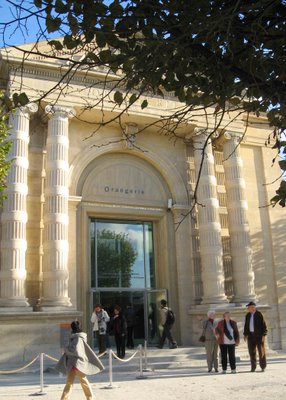
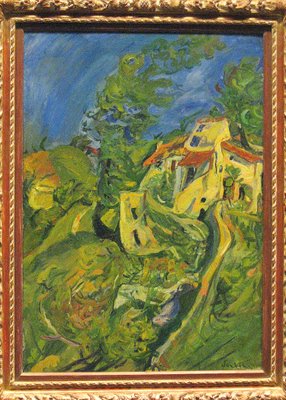
Above are a couple of the many photos I took while visiting the refurbished Musee de l'Orangerie in Paris about ten days ago. Although I knew most of the artists presented, Chaim Soutine (above, right) was completely new to me. Very interesting.
Two other of my photos have migrated downwards into the following article which describes the background and collection in this little jewel in the center of Paris. Again, "vaut le voyage", in Michelin terminology.
History of the Orangery
Citrus trees grown in tubs and wintered under cover were a feature of Renaissance gardens, once glass-making technology enabled sufficient expanses of clear glass to be produced. The Orangerie at the Palace of the Louvre, 1617, inspired imitations that were not eclipsed until the development of the modern greenhouse in the 1840s. An orangery was a feature of royal and aristocratic residences through the 17th and 18th centuries.
Some of the better known orangeries in Europe include those at the Château de Versailles, the Tuileries Gardens in Paris, the Schönbrunn in Vienna (Austria), the Orangerieschloss in Potsdam (Germany), and the Orangery at Margam Park (Wales).
Designed by architects Firmin Bourgeois and Ludovico Visconti, the Orangerie des Tuileries in Paris is a pavilion greenhouse structure, built in 1852 during the Second Empire, under Napoleon III. It is situated in the southwest corner of the magnificent Tuileries Gardens, facing the Place de la Concorde. The building is an architectural twin of the Jeu de Paume, located in the northwest corner, which was built in 1851 to house two tennis courts for Napoleon. (see Galerie Nationale du Jeu de Paume)
Birth of the Orangery Museum in Paris
During a span of 25 years between the 1890s and 1920s, the French painter Claude Monet had been busy painting diverse renditions of the Nymphéas (Water Lilies) which he had planted in the pond of his gardens at Giverny, Normandy. The feverish pace of his work produced nearly 250 canvases on this subject.
| "Suddenly I had the revelation of how magical my pond is. I took up my palette. Since that time I have scarcely had any other model." Claude Monet (1840-1926). "Dear and close friend, Claude Monet to Georges Clémenceau, |
In 1922, he offered to donate eight giant (2x6m) panels of Nymphéas to the French state, if a suitable venue could be found for their display. The government selected the site of the Orangerie in Paris to exhibit them.
Working according to Monet's exacting specifications, the architect Camille Lefèvre created a space for the works in the form of an oval gallery, whose curved walls would hold the huge paintings. The Musée de l'Orangerie had been born, though Monet's paintings were not installed until 1927, a year after the artist's death.
As works by other Impressionist artists were acquired by the museum in subsequent years, it was decided to expand the gallery space further. During the 1960s, architect Olivier Lahalle added a second story to the building, directly above Monet's Nymphéas. However, the new floor also covered existing skylights, which rendered the building dark and claustrophobic.
For the next several decades, this second level housed the Jean Walter and Paul Guillaume art collection which was on loan to the museum — 144 pieces consisting of works by Cézanne, Derain, Laurencin, Maillol, Matisse, Modigliani, Picasso, Renoir, Rousseau (Le Douanier), Soutine, and Utrillo. In 1984, Domenica Walter — the widow of both Walter and Guillaume — sold the collection to the state, with the provision that it not be disseminated to other locations.
In 1999, it was decided that the lower space should be opened up once again to natural light, while also creating a direct access to Monet's Nymphéas from the entry hall. The upper floor would be removed, and in its place a 3100m2 (33,368 sq. ft.) subterranean gallery was to be built — adding a boutique, education facilities and toilets in the process. Furthermore, an installation of air-conditioning would not only serve to stabilize the priceless works of art, but would provide comfort for the half-million people who visit each year.
The museum was closed to the public in early January 2000, following a final grand exhibition in 1999 entitled Monet: le cycle des Nymphéas — orchestrated by the museum's director, Pierre Georgel. The exhibit borrowed a number of other Monet pieces from museums and private collections around the world.
An architectural firm — Agence Brochet / Lajus / Pueyo of Bordeaux — was chosen to direct the renovation project in concert with Betom Ingénierie. Architect Michel Goutal, Director of Historic Monuments, was also appointed to oversee portions of the project. Application for a construction permit was made by the Prefect of Paris on October 22, 2001.
The completely modernized museum was meant to reopen by the fall of 2004. Unfortunately, a fly in the ointment stalled the project.
Renovation Mishap
Renovation work on the museum came to a grinding halt in August 2003, when construction crews excavating in the basement discovered the stones of an ancient defensive wall which once encircled the City of Paris. Since this wall was not mentioned in the permit application, further digging was delayed until an assessment of its historic and archaeological significance could be made. (see press release of 17 September 2003)
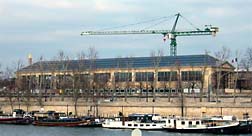 Musée de l'Orangerie under construction, viewed from across the Seine River. | |
At first, the stones were thought to be part of the city's defenses built during the 16th century by Charles IX (who ceremoniously laid the first stone in 1566), or possibly that of a later addition by Henry III (1583-1586).
However, upon further examin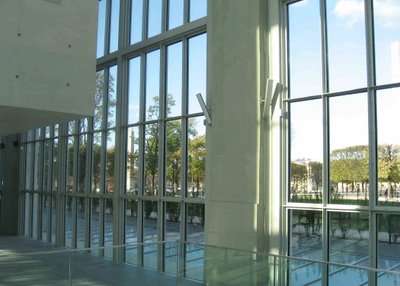 ation, it was revealed that the structure was part of Louis XIII's third and last set of walls built during the period of 1632-1637. Known as Les Fossés Jaunes — literally, "yellow trenches", so named due to the color of the limestone which was quarried in Saint-Leu — this bastion was designed to support an artillery platform for the Thirty Years War (1618-1648).
ation, it was revealed that the structure was part of Louis XIII's third and last set of walls built during the period of 1632-1637. Known as Les Fossés Jaunes — literally, "yellow trenches", so named due to the color of the limestone which was quarried in Saint-Leu — this bastion was designed to support an artillery platform for the Thirty Years War (1618-1648).
Upon learning of this monumental discovery, a number of architectural conservationists — including Pierre Housieaux, president of Paris Historique, and Olivier de Monicault, president of the association S.O.S. Paris — called for preservation of the wall's remnants. (see copy of an open letter signed by both these men)
The Minister of Culture and Communication, Jean-Jacques Aillagon, convened a panel of academic experts and museum curators to study the site. Based on their findings released in January 2004 (see copy of their report), he decided that two important sections of the fortification should be preserved. As a result, the re-opening of the museum has been further delayed beyond its already revised 2006 estimate, and the project will add another €3 million to the original €25 million budgeted for the facility's renovation.
Critics of the renovation project are apalled that the Ministry of Culture was apparently unaware of the wall's existence, pointing out that anyone visiting the Louvre's shops can obtain maps of old Paris which clearly delineate the ancient city defenses. In any case, creating a gallery below the museum has proven to be a creative challenge for the architects, since Louis XIII's walls cut diagonally across the space.
It is certain that the Ministry of Culture will take great pains to preserve these traces of the city's heritage, for the public's benefit. Excavation work on the Louvre's courtyards during the late 1980s had uncovered portions of the original castle's walls and moat — dating back to Philippe Auguste (13th c.) and Charles V (14th c.) — which are now open to the public. No doubt, similar treatment will be accorded to this recent find beneath the Orangerie.
Meanwhile, the Nymphéas remain protected in temperature-controlled glass cases, and anti-vibration equipment has been installed to protect the works of art during underground digging. It remains to be seen whether the Musée de l'Orangerie will re-open before the end of this decade, but it will probably be worth the wait.
Editor's note: Another archaeological site which offers a fascinating glimpse at the ancient history of Paris is the Archaeological Crypt of the Parvis at Notre Dame.
Masterpieces in the Musée de l'Orangerie:
|
|
Editor's note: There are plans to add modern works by Giacometti, Miro, and Rodin.
Location: Place de la Concorde, 75001 Paris. Phone: 01-42-97-48-16.
Métro: Concorde (lines 1, 8, 12). RER: Invalides, Musée d'Orsay (line C).
Hours: Wednesday - Monday, 9:45 a.m. - 5:15 p.m. (closed for renovations until 2006)
Admission: Adults - € 4, students & under 19 - free.
Web site: http://www.rmn.fr/gb/02musees/01presentation/musees/orangerie/orangerie.html
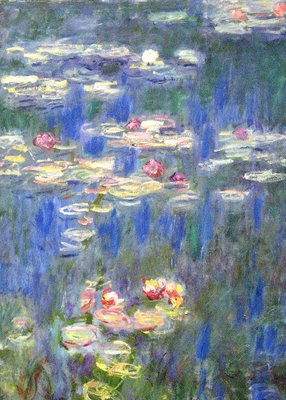
No comments:
Post a Comment